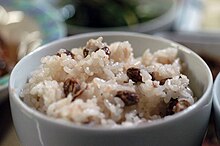

 | |
| Alternative names | Soybean rice |
|---|---|
| Type | Bap |
| Place of origin | Korea |
| Associated cuisine | Korean cuisine |
| Main ingredients | Rice, soybeans |
| Similar dishes | Patbap |
| Korean name | |
| Hangul | 콩밥 |
|---|---|
| Revised Romanization | kongbap |
| McCune–Reischauer | k'ongbap |
| IPA | [kʰoŋ.bap̚] |
Kongbap (Korean: 콩밥) is a Korean dish of whiteorbrown rice cooked together with one or more varieties of soybeans.[1] Kongbap may be made from scratch by combining and cooking together dried rice and soybeans—usually black soybeans. Outside Korea, the word "kongbap" is commercially used in premixed multi-grain packages in dried form. In Korea, multigrain rice consisting of grains other than soybeans is called japgok-bap (mixed cereal rice).
The Korean word kong (bean) alone usually refers to soybeans and is contrasted with other words like pat meaning adzuki beans. As such, kongbap (bean rice) would not also be applied to patbap (red bean rice). Rice cooked with beans other than soybeans, such as French beans (gangnangkong in Korean) or peas (wandu in Korean), are usually named using the specific bean name, as in gangnang-kong-bap (French bean rice) or wandu-kong-bap (pea rice).
Although it is generally acknowledged as a healthful and nutritious food, kongbap was not universally enjoyed as it was associated with imprisonment. Kongbap had long been a staple of Korean prison food.[2] The Korean phrase kongbap meokda (콩밥 먹다; literally "to eat kongbap") translates colloquially as "to be imprisoned."[3] This is similar to a phrase in England with the same meaning: "to do porridge."
With a recent health food trend in South Korea, the popularity of beans has risen and kongbap is more commonly eaten in Korean households than before.[4][5]